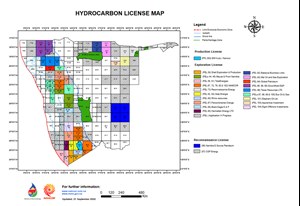The sky may be falling, but not right now in the global fossil energy business. No driven ideology can alter the simple fact that all living persons benefit daily from fossil energy. So, reality requires expanding exploration for fossil fuels. Governments are “allowing” more access offshore. European leaders admit to Chevron that natural gas is the long-term play in reducing “climate change” emissions! All energy matters (t-shirt slogan) and should be pursued.
Since lithium is rare, and the perfect adiabatic device has yet to be obtained, world peace must muddy by with what we know we have. Examining the pages of recent exploration announcements in World Oil says one thing, exploration is WINNING! You would think we are in “fat city.”
Points of interest posted in World Oil:
- CGX Energy Inc. and Frontera Energy Corporation—discovered oil offshore Guyana, encountered 210 ft of hydrocarbon-bearing sands
- Shell—Pierce Field, UK North Sea, to increase production
- Equinor—BM-C-33 offshore Brazil moves forward
- Ecopetrol—calls for Colombia to drop exploration ban, ExxonMobil drops out
- Petrobras makes offshore oil discovery
- Qatar Energy—plans exploration Suriname,
- Aker BP—makes upgrade to exploration discovery, beating predrill estimates
- ExxonMobil returns to new fracing tech in shale (yea!), to continue producing oil, gas
- TGS—reinvents 2D to 3D seismic data in new project offshore Brazil
- PGS, SLB, TGS—sign 3D multi-client reprocessing agreement offshore Malaysia
- Ikon Science—improves “normal” workflows, in exploration to production
- Total—makes a commercial discovery offshore Nigeria
- Zion Oil & Gas—“Our future plans include additional exploration projects”
- CNOOC plans offshore oil, gas exploration in Tanzania.
See a theme? Offshore rig prices continue to rise, due to exploration demand and exploitation of recent discoveries.
Observations from Carbon Intel Forum. This May’s Gulf Energy Information-hosted Carbon Intel Forum in Houston was well- attended. Presenters spoke about using CO2 in alternate substances like cement. Some issues with carbon capture were discussed, along with the yet-to-be-solved problem of keeping CO2 sequestered underground for more than a few years. Current tax incentives molded the room’s attendance. I couldn’t help myself when asking a presenter about how much fossil fuel will be needed to commercialize his company’s cement process. He did not know. I was later “corrected” by DOE-NETL that the process used joules, not gas Btu’s. You think there could be some misunderstanding about which end of the gas pipe I was referring to? My point? Fossil fuel is required, because neither solar nor wind can produce enough watts to bake cement.
Namibia claims a find. I read with delight that according to a Namibian national spokesperson in Africa, Total Namibia found “billions of barrels” of oil offshore, Fig. 1. I heard a similar pronouncement from a Brazilian spokesperson about a Texaco discovery on Marajo Island, circa 1985. Since I was on that very small, flat sandy island for Marathon Oil at the time, I supposed that Texaco’s drill rig was just “missing.” I must have been looking downward; too concerned with piranha and anacondas.
SPWLA’s annual conference was held recently in Houston. I feature workshop #4, The Importance of Petrophysics in Resources and Reserves Estimation. Resources and reserves estimation is an essential task in our industry for internal resources accounting, financial transactions, and regulatory reporting at the very least. To ensure consistency, transparency and reliability for these estimations, several entities have developed guidelines. Although the Petroleum Resources Management System by SPE, AAPG WPC, SPEE, SEG, EAGE and SPWLA is a recognized industrywide standard, different guidelines are tied to different countries and stock exchanges/markets.
So, with this background, what is the role of Petrophysics in resources and reserves assessment? Also, what are fit-for-purpose guidelines (emphasis on guidelines, not rules) that are reasonable and necessary? Expectations: The participants will understand the key role that petrophysics plays in reserves and resources estimation, and ultimately on assets’ values.
SPWLA featured several workshops: Classification, Framework and Definition of Resources; The role of Petrophysics in resources and reserves estimation; Net Pay Definition; Evaluation & Integration methods; and Introduction to 2022 updated PRMS Application Guidelines.
Stated prerequisites: A basic understanding of petrophysical evaluation, multi-discipline integrated subsurface studies, and project management. Advanced knowledge of field development planning and regulations is advisable, but not essential. (Really?)
Did any of your people attend? The future of micro analysis of profitable reservoir rock is undergoing radical improvements with very few publication releases.

- The reserves replacement dilemma: Can intelligent digital technologies fill the supply gap? (March 2024)
- What's new in exploration (January 2024)
- Dallas Fed: E&P activity essentially unchanged; optimism wanes as uncertainty jumps (January 2024)
- What's new in exploration (September 2023)
- What's new in exploration (May 2023)
- Regional report: South Australia: New life in a mature basin: S.A.’s Cooper basin CCS and exploration opportunities (May 2023)



